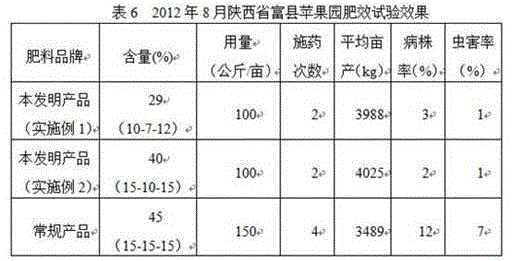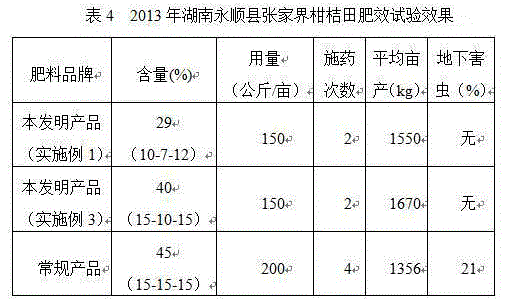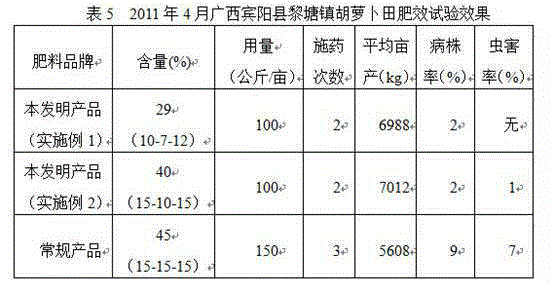Citrus reticulata blanco compound fertilizer and production method thereof
A compound fertilizer and citrus technology, applied in fertilization devices, fertilizer mixtures, applications, etc., can solve problems such as affecting yield and large fruit drop, and achieve the effects of improving utilization rate, loosening soil, and increasing the content of effective bacteria.
- Summary
- Abstract
- Description
- Claims
- Application Information
AI Technical Summary
Problems solved by technology
Method used
Image
Examples
Embodiment 1
[0051] Prepare citrus compound fertilizer with 29% of total nitrogen, phosphorus and potassium nutrients (10-7-12) and 20% of organic matter (10-7-12 respectively refer to N, P 2 o 5 、K 2 The nutrient percentage content of O, the same below).
[0052] Raw material formula ratio: 165 kg of urea (calculated as 46.0% containing N), 155 kg of diammonium phosphate (calculated as 16% containing N, containing P 2 o 5 According to 46.0%, 5 kg of calcium magnesium phosphate fertilizer (including P 2 o 5 18.0%, 9% Mg, 28.4% Ca, 12.7% Si), 240 kg potassium sulfate (K 2 O is calculated as 50.0%, and S is calculated as 17.0%) (including K 2 O based on 60.0%), borax 1 kg (containing B based on 11%), zinc sulfate heptahydrate 0.5 kg (containing Zn based on 23%), ammonium molybdate 0.5 kg (containing Mo based on 54%), copper sulfate 0.5 kg (including 23% Cu), 100 kg of amino acid, 232.5 kg of organic fertilizer (including 24 kg of molasses alcohol waste liquid, 46 kg of algae), 100 kg ...
Embodiment 2
[0058] Prepare citrus compound fertilizer with 35% of total nitrogen, phosphorus and potassium nutrients (13-10-12) and 20% of organic matter (13-10-12 respectively refer to N, P 2 o 5 、K 2 The nutrient percentage content of O, the same below).
[0059]Algae, molasses alcohol waste liquid, sugar factory filter mud and cane pith are added to the product obtained by fermenting after pretreatment by fermentation bacteria. The molasses alcohol waste liquid accounts for 10-15% of the total weight of the organic fertilizer.
[0060] The fermenting bacteria adopt the special decomposing strains for bio-organic fertilizers produced by Guangzhou Nongguan (Taiwan-funded) Biotechnology Co., Ltd., and the strains are first expanded and cultivated. The composition of the medium is: 3-5% corn flour, 20-60% molasses, 0.01-0.15% potassium chloride.
[0061] Raw material formula ratio: 210 kg of urea (calculated as 46.0% containing N), 220 kg of diammonium phosphate (calculated as 16% cont...
Embodiment 3
[0065] Prepare citrus compound fertilizer with 40% of total nitrogen, phosphorus and potassium nutrients (15-10-15) and 20% of organic matter (15-10-15 respectively refer to N, P 2 o 5 、K 2 The nutrient percentage content of O, the same below).
[0066] Raw material formula ratio: 250 kg of urea (calculated as 46.0% containing N), 220 kg of diammonium phosphate (calculated as 16% containing N, containing P 2 o 5 According to 46.0%, 5 kg of calcium magnesium phosphate fertilizer (including P 2 o 5 18.0%, 9% Mg, 28.4% Ca, 12.7% Si), 300 kg potassium sulfate (K 2 O is 50.0%, S is 17.0%), borax is 2 kg (B is 11%), zinc sulfate heptahydrate is 0.5 kg (Zn is 23%), ammonium molybdate is 0.5 kg (Mo is 54 %), 0.5 kg of copper sulfate (calculated as 23% of Cu), 50 kg of amino acid, 150 kg of organic fertilizer (including 20 kg of molasses alcohol waste liquid, 25 kg of algae), and 21.5 kg of fly ash.
[0067] Algae, molasses alcohol waste liquid, sugar factory filter mud and cane...
PUM
 Login to View More
Login to View More Abstract
Description
Claims
Application Information
 Login to View More
Login to View More - R&D
- Intellectual Property
- Life Sciences
- Materials
- Tech Scout
- Unparalleled Data Quality
- Higher Quality Content
- 60% Fewer Hallucinations
Browse by: Latest US Patents, China's latest patents, Technical Efficacy Thesaurus, Application Domain, Technology Topic, Popular Technical Reports.
© 2025 PatSnap. All rights reserved.Legal|Privacy policy|Modern Slavery Act Transparency Statement|Sitemap|About US| Contact US: help@patsnap.com



